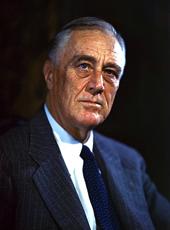
White House Statement on Distribution of Electricity by the New York Power Authority.
A report on Cost of Distribution of Electricity adopted as a basis for the marketing of 1,100,000 horse power of current from the St. Lawrence River was filed today by the Power Authority of the State of New York with the President, after a three-year survey initiated under his administration as Governor.
This represents the first field survey and analysis ever undertaken and successfully completed on costs specifically segregated to cover distribution of electricity from the sub-station to the customer's meter. Generating and transmission costs of electricity have long been known and may readily be estimated for new power developments.
The report filed today establishes a yardstick on rates for the Northeastern area of the United States which can be applied to every city, town and rural community in connection with the development of the St. Lawrence River as a public power project. By use of this yardstick a saving of $194,000,000 a year for customers in New York, Pennsylvania, New Jersey and New England is shown by detailed figures included in the report.
The report has been filed simultaneously with the President, Governor Lehman and the Federal Power Commission. Local cost-of-distribution figures and reports are being made available to the mayors of seventeen municipalities in New York, including New York City, and of twelve cities in five other States in the Middle Atlantic, South Atlantic, North Central and Pacific Coast areas to which the study extended. A total of twenty-nine cities in six States were included in the survey.
The findings in the report vitally affect 7,000,000 customers for electricity throughout the Northeast and link the public power development on the St. Lawrence River with the national yardstick policy already in effect on the Tennessee, Columbia and Colorado Rivers.
Its major conclusions are as follows:
1. The cost of distributing electricity to homes and farms in New York State warrants a rate schedule which would charge not more than 3 1/2¢ a kilowatt hour for a use of 50 kilowatt hours a month instead of the average of 64 which these customers are now paying. In terms of the monthly bill this would mean a reduction from $3.00 to $1.65, representing a saving of $1.35 a month, or more than $16.00 a year for this service.
2. The monthly savings would be even greater for the increased use of electricity which will follow such rate reductions. As home consumption rises above 50 kilowatt hours per month the rate schedule which this survey justifies would provide current at a steadily diminishing average cost per kilowatt hour. For a monthly use of 100 kilowatt hours the bill should not exceed $2.70, for 200 kilowatt hours, $4.20, and for 400 kilowatt hours used in a single month the home should not pay more than $6.80.
3. This means that when rate schedules are reduced to the measure provided by the public yardsticks being set up under the national power program, a majority of homes should get more than 100 kilowatt hours for the monthly bills under which they now get only 50 kilowatt hours. In some cities in New York State bills are being paid for 50 kilowatt hours which should buy 200.
4. The reduction in charges to small business customers in the commercial class, to correspond with the cost of distribution found to be justifiable by this survey, would similarly cut the monthly bill of $9.00 for an average use of 184 kilowatt hours to about $5.40. This would mean a saving of $3.60 a month, or about $43.20 a year to the average customer in this class of service. With larger commercial use the monthly and annual savings would be greater.
5. The costs upon which these conclusions rest are for private operation of electric systems, including a 6 percent return on all useful fixed capital, and an additional 5 1/2 percent to cover depreciation, taxes and insurance. Municipalities owning their own electrical systems, the report shows, could provide service even more cheaply while carrying the full burden of fixed charges, including property, franchise and state and federal income taxes today borne by private companies.
6. When it is considered that the total electric bill of New York State is nearly $300,000,000 a year and that the consumers of electricity in the Northeastern States which will be affected by this yardstick pay over $681,000,000 annually for this service, it is apparent that the savings will be very large and will materially reduce the overhead cost which depresses the spending power of consumers throughout these states. The report estimates savings totaling $63,000,000 a year for New York State alone, or a reduction of 22 percent in the total electric bill. For the Northeastern area which will be affected by the yardstick the savings, including those on municipal street lighting, are estimated at $194,000,000, representing a reduction of 27 percent in the total now paid for electricity.
Franklin D. Roosevelt, White House Statement on Distribution of Electricity by the New York Power Authority. Online by Gerhard Peters and John T. Woolley, The American Presidency Project https://www.presidency.ucsb.edu/node/208213
